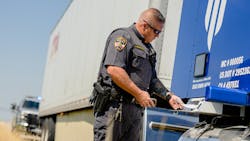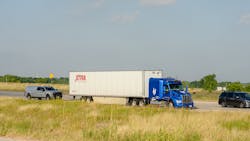Embark engineers create way for law enforcement to interact with self-driving trucks
Autonomous trucking technology developer Embark Trucks recently completed a public demonstration of its emergency vehicle interaction capability.
Working with the Texas Department of Public Safety and the Travis County Sheriff’s Office, Embark developed a way for Embark-powered trucks to identify and stop for law enforcement vehicles. Embark also built communication protocols and standard operating procedures for autonomous trucks to interact with law enforcement during traffic stops.
See also: Zero trust: Chaos creates cybercriminal opportunitiesEmbark said this is the first public demonstration of an autonomous truck being pulled over by law enforcement and participating in a routine traffic stop on a public highway. The company created a video detailing how the system works:
“The ability to engage safely in emergency vehicle interactions is necessary to operate an autonomous vehicle on public roads,” said Emily Warren, head of public policy at Embark. “Law enforcement always needs to be able to stop a commercial vehicle—autonomous or not—to ensure compliance with the law. This capability was designed to work seamlessly within existing law enforcement workflows, without requiring new training or technology investment by first responders.”
Embark, Travis County, and Texas DPS used comprehensive data collection and testing from April to June this year. That testing included closed-course activity at the Texas A&M University RELLIS Campus test track as well as public road demonstrations.
The public demonstration took place in late June on Texas State Highway 130 near Austin. Travis County’s Commercial Vehicle Enforcement division deputies followed an Embark-powered truck along a designated route and successfully completed a traffic stop of the Embark truck.
A deputy was able to confirm the truck was safe to approach via an external status display on the side of the truck, then walked through the procedure of accessing the truck’s documentation via an external lockbox, using a code that would be provided by a remote Embark Guardian support technician.
The demonstration concluded after the deputy completed his traffic stop and followed the truck as it re-entered highway traffic. Embark published a white paper detailing this procedure and how it can be replicated in other jurisdictions.
Embark’s roadmap to commercialization
On Embark’s technical capabilities roadmap, which details the 16 capabilities required to commercially deploy autonomous trucks in the U.S. Sunbelt, the emergency vehicle interaction capability represents the next milestone achieved by the company. With the completion of this successful public demonstration, Embark has reached 12 technical milestones on its roadmap, marking another step toward its commercial deployment.
Embark’s emergency vehicle interaction capability has two components:
- Embark’s engineering team built the technical functionality for the capability. This included training Embark-powered trucks to identify emergency vehicles via lights and other cues and then respond accordingly by pulling over safely onto highway shoulders.
- Embark developed an interaction procedure with input from law enforcement that can enable any law enforcement officer to stop safely, approach, and receive information from an autonomous truck intuitively and without any additional equipment. When commercially deployed, this effort may include outfitting Embark trucks with clear visual cues and information to signal to law enforcement and other first responders that an Embark-powered truck is an autonomous vehicle and has come to a safe stop without risk of restarting unexpectedly. Embark’s externally accessible lockbox, containing information such as registration and bills of lading, as well as a toll-free number to contact an Embark Guardian support technician, are also included in the company’s plans to assist law enforcement officers as they perform roadside traffic stops.
Embark said these features together represent a comprehensive process for Embark-powered trucks to comply with law enforcement requests, just like a human-driven truck would respond in similar situations.
About the Author
Josh Fisher
Editor-in-Chief
Editor-in-Chief Josh Fisher has been with FleetOwner since 2017. He covers everything from modern fleet management to operational efficiency, artificial intelligence, autonomous trucking, alternative fuels and powertrains, regulations, and emerging transportation technology. Based in Maryland, he writes the Lane Shift Ahead column about the changing North American transportation landscape.


